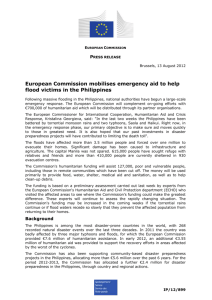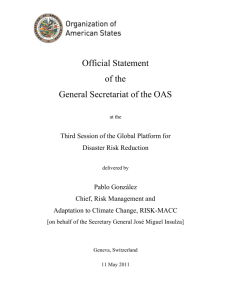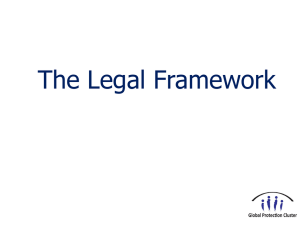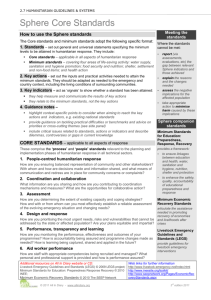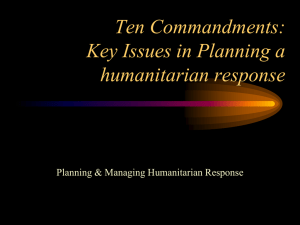During the past century, the earth`s climate increased by approximately
advertisement
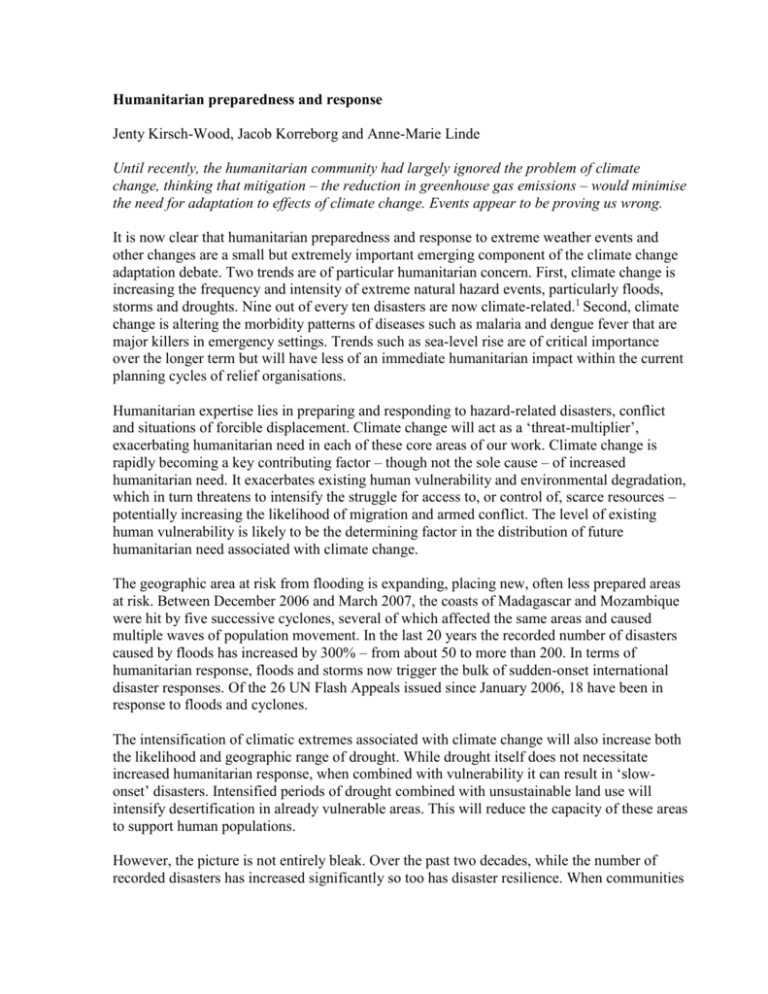
Humanitarian preparedness and response Jenty Kirsch-Wood, Jacob Korreborg and Anne-Marie Linde Until recently, the humanitarian community had largely ignored the problem of climate change, thinking that mitigation – the reduction in greenhouse gas emissions – would minimise the need for adaptation to effects of climate change. Events appear to be proving us wrong. It is now clear that humanitarian preparedness and response to extreme weather events and other changes are a small but extremely important emerging component of the climate change adaptation debate. Two trends are of particular humanitarian concern. First, climate change is increasing the frequency and intensity of extreme natural hazard events, particularly floods, storms and droughts. Nine out of every ten disasters are now climate-related.1 Second, climate change is altering the morbidity patterns of diseases such as malaria and dengue fever that are major killers in emergency settings. Trends such as sea-level rise are of critical importance over the longer term but will have less of an immediate humanitarian impact within the current planning cycles of relief organisations. Humanitarian expertise lies in preparing and responding to hazard-related disasters, conflict and situations of forcible displacement. Climate change will act as a ‘threat-multiplier’, exacerbating humanitarian need in each of these core areas of our work. Climate change is rapidly becoming a key contributing factor – though not the sole cause – of increased humanitarian need. It exacerbates existing human vulnerability and environmental degradation, which in turn threatens to intensify the struggle for access to, or control of, scarce resources – potentially increasing the likelihood of migration and armed conflict. The level of existing human vulnerability is likely to be the determining factor in the distribution of future humanitarian need associated with climate change. The geographic area at risk from flooding is expanding, placing new, often less prepared areas at risk. Between December 2006 and March 2007, the coasts of Madagascar and Mozambique were hit by five successive cyclones, several of which affected the same areas and caused multiple waves of population movement. In the last 20 years the recorded number of disasters caused by floods has increased by 300% – from about 50 to more than 200. In terms of humanitarian response, floods and storms now trigger the bulk of sudden-onset international disaster responses. Of the 26 UN Flash Appeals issued since January 2006, 18 have been in response to floods and cyclones. The intensification of climatic extremes associated with climate change will also increase both the likelihood and geographic range of drought. While drought itself does not necessitate increased humanitarian response, when combined with vulnerability it can result in ‘slowonset’ disasters. Intensified periods of drought combined with unsustainable land use will intensify desertification in already vulnerable areas. This will reduce the capacity of these areas to support human populations. However, the picture is not entirely bleak. Over the past two decades, while the number of recorded disasters has increased significantly so too has disaster resilience. When communities are prepared, they are less likely to be permanently displaced in the face of a hazard event. Well planned initiatives for environmental protection, land-use planning, natural resource management and settlement development can substantially reduce disaster risks. Access to basic needs Climate change will affect both water quantity and water quality. Increased salination of water supplies in coastal areas and pressure on existing water management systems are likely, due to flooding. Drought will also exacerbate salination and degradation of water systems. Drought, and climate unpredictability, will also impact agricultural yields. Agriculture fed by rainfall is projected to halve in some African countries by 2020. In addition, the cost of basic food commodities has increased 50% in the past five years, and in-kind food donations are decreasing. This suggests that rapid changes in agricultural practices and access to food are required if increases in humanitarian levels of malnutrition are to be mitigated or prevented. The humanitarian community will in all likelihood be required to respond more frequently to drought-related food insecurity resulting in emergency levels of malnutrition, particularly in complex emergency settings where development actors will be less able to intervene. Increases in temperatures resulting from global warming have also begun to extend the range in which diseases such as malaria and dengue fever can thrive. While populations in wellestablished high-prevalence zones often have a degree of local immunity, newly exposed populations are more susceptible.2 Displacement and migration There is growing debate over whether climate change-affected populations are a ‘new’ group in need of protection and if existing legal frameworks are sufficient to provide for their protection. Within the humanitarian and risk reduction communities, however, these same populations have generally been seen as falling within existing, and expanding, caseloads. It is clear that climate change will contribute both to increased temporary displacement and longer-term migration. The results of modelling longer-term changes in coastlines as a result of rising sea levels suggest that governments may be required to support mass movements of coastal populations after approximately 2080. However, in the period up to 2030, sea-level rise is less likely to be a major source of migration and humanitarian need. Prior to that period, increased flood and drought vulnerability are likely to be the main driver of temporary displacement and will result in increased humanitarian needs. Flood risk may be particularly intense in coastal areas and among growing urban slum populations. Drought and increased food insecurity may also increase migration in some cases, particularly into urban areas. For example, research in sub-Saharan Africa in the 1990s indicated that some 7 million people – out of the 80 million considered to be food-insecure – used migration as a coping strategy during periods of drought.3 Increased vulnerability and heightened competition for basic resources may also exacerbate migration and the potential for conflict. Humanitarian systems must expect that a significant number of disasters will occur in conflict settings, such as Afghanistan, Somalia, Haiti, Sudan or the DRC, and it is likely that this will fuel migration, social tensions and a need for increased international humanitarian assistance. How big will the problem be? The actual extent and humanitarian impacts of this trend will be based on a complex mix of factors, making modelling of these trends extremely difficult. The complex inter-relationship of vulnerability, exposure and capacity means it will not be possible to accurately predict migration flows likely as a result of climate change, any more than we can accurately ‘predict’ wars. Increased drought in an area of very low population density will not have the same impact as drought in a populated area. Less water may be manageable in a richer area but may lead to the depopulation of a poorer community. The needs of different affected populations will be extremely diverse. It will be important, therefore, to place trend analysis at least within broad timeframes and to differentiate between the humanitarian short-term migration impacts and those that are perhaps more extreme but essentially longer-term in nature. It is also essential to recognise that it is not, and will not, be possible to isolate climate change as a cause of either migration or displacement. Rather climate change may contribute to environmental and social trends that make it difficult for vulnerable people to survive where they are. Reliable attribution that can link a particular hazard event first to climate change, and then to migration, would be extremely difficult, if not impossible. We must be careful in considering new categories of ‘environmental migrants’ and ‘climate change migrants’ not to undermine existing rights. There has been an increasing body of work to link international human rights law and customary legal norms on internal displacement to situations of disasters associated with natural hazards. The IASC Guidelines on Human Rights in Natural Disasters4 are an example of this. Creating new, perhaps overlapping, categories should not undermine hard-won gains in these areas. Voluntary migration should also not be confused with forced displacement. And, particularly in the context of disasters, short-term migration should not be confused with long-term displacement. It was precisely Bangladesh’s capacity to help three million people to voluntarily move out of harm’s way in the wake of Cyclone Sidr that saved thousands of lives in November 2007. In the context of rapid-onset disasters, even short-term forced displacement is legally sanctioned under certain conditions, as it is precisely the ability to move that saves lives. The vast majority of those displaced return home, and can and should be supported to rebuild in a risk-appropriate manner. These disaster-affected people should probably not be included in calculations of ‘environmentally induced migrants’. Conclusions We are currently at a critical moment in time. We know enough to be able to prevent significant migration related to climate change – if we can harness the vision and action that can bring about actual change. However, policymakers should recognise that over the next two decades one of the major impacts of climate change will be an increase in existing types of climate-related humanitarian need. Scaling up existing investment in disaster preparedness and response is therefore essential. The 2005 Hyogo Framework for Action (HFA) provides a framework for how to reduce disaster risk, and includes early warning and preparedness for response as key priorities.5 Current disaster preparedness and response mechanisms will need to be adapted to conflict settings and to address issues such as migration, protection and conflict prevention. Proactive analysis of the probable costs of increased disaster response activities for international humanitarian actors is also necessary. According to the UN’s humanitarian Financial Tracking Service, funding for natural disaster responses currently accounts for roughly US$804 million – 10% of overall humanitarian funding of approximately US$7.7 billion. The 2007 UNDP Human Development Report6 estimates that, as a result of climate change, an additional US$2 billion will be needed annually to strengthen disaster response by 2015 (although this figure is subject to considerable debate). Solutions to key questions such as whether increased funding will be expected to come from humanitarian, development or climate change adaptation funding ‘pots’ are basic but as yet unresolved issues that may have a huge impact on emerging systems to meet increasing need. While some improvements may be possible, the complexity of both climate modelling and social systems means that clear reliable projections of future trends in key areas such as migration, conflict, urbanisation and financial cost are impossible. We must act on a sound analysis of past trends – and on best guesses. Without improved multi-disciplinary analysis, legal definitions to try to capture the impact of climate change on human lives will be meaningless. Jenty Kirsch-Wood (kirsch-wood@un.org) is Humanitarian Affairs Officer, Disaster and Vulnerability Policy in UNOCHA (http://ochaonline.un.org), Jacob Korreborg (jakan@kemin.dk) formerly worked in Disaster and Vulnerability Policy in UNOCHA and currently works on international climate change adaptation in the Danish Ministry of Climate and Energy, and Anne-Marie Linde (lindea@un.org) is Humanitarian Affairs Officer, Displacement and Protection Support Section in UNOCHA. The paper was written in their personal capacities, and the views and opinions expressed do not necessarily state or reflect those of the UN or the Danish government. 1 P Hoyois et al, CRED 2007b, Annual Disaster Statistical Review 2006, Brussels, May 2007, pp18-25. www.em-dat.net/documents/Annual%20Disaster%20Statistical%20Review%202006.pdf 2 See article by Carballo, Smith & Pettersson, pp… 3 Myers (2005) based on Myers, N, and Kent, J (1995), Environmental exodus: an emergent crisis in the global arena, The Climate Institute, Washington, DC 4 http://www.humanitarianreform.org/humanitarianreform/Portals/1/cluster%20approach%20page/clusters%20pag es/Protection/IASC_Op%20Guidel&Manual%20on%20HR&Nat%20Disasters_2008.pdf 5 www.unisdr.org/eng/hfa/ 6 http://hdr.undp.org/en/reports/global/hdr2007-2008/

